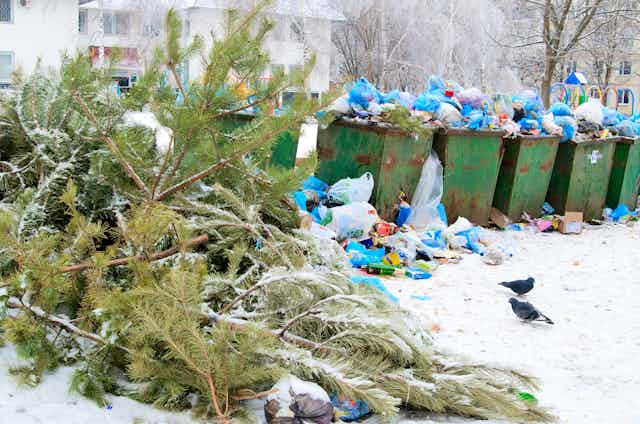The holiday season has a waste problem.
On average, each Canadian produces 720 kilograms of municipal waste — more than the per capita output in the United States and double what is produced in Japan. And over the holidays, our waste volumes double.
Think about it: We’re each throwing out several additional kilos of holiday food, plastic packaging, foil wrapping and household goods each day.
Reducing waste this holiday season requires a whole new approach, a complete redesign of how we plan and celebrate this time of year.
Design can help us create a different future — and a new way of thinking about the holidays that takes aim at the way we consume day-to-day.
Take back the tinsel
Waste management costs Canadian taxpayers several billion dollars each year. During the holidays, we are paying to buy new stuff and then paying some more to take away the castoffs and detritus of Christmas.
We’re not even doing it right. Municipal employees have indicated that consumers don’t know how to deal with shiny, crinkly Christmas stuff that’s not part of everyday recycling. Tree ornaments, gift wrapping and the unwanted Elves on the Shelves wind up in the wrong bins.
According to the Recycling Council of British Columbia, an estimated 545,000 tonnes of waste is generated in Canada from gift-wrapping and shopping bags alone. It estimates that if each Canadian family simply cut down on their waste by just one kilogram for the two-week holiday, 34,000 tonnes of garbage would be eliminated.
Food fright
We also tend to overbuy, bake and cook over the holidays. What doesn’t get eaten winds up in the trash — or the green bin if your municipality supports a composting program. In Canada, we throw out $31 billion in food per year. While a good portion of that comes from restaurants and grocery stores, 47 per cent of food waste it generated by consumers.
Following the holiday break, municipal waste authorities describe finding whole turkeys in the garbage, large amounts of baked goods and mountains of leftovers from holiday parties.
If all the extra organic refuse is not diverted or captured, it winds up in a landfill where it produces methane, a greenhouse gas that is far more potent than carbon dioxide.
We’re not just throwing away food, but also money. In its most recent food waste report, Value Chain Management International estimates that the value of our food waste is “higher than the combined GDP of the 29 poorest countries.”
The waste numbers are alarming, not only because they are huge but because they are unnecessary. Yet they’re a direct consequence of our consumer lifestyles where the preference is for new things, especially at Christmas.
Redesign the holidays
To change our waste, we need to celebrate the holidays with an entirely new approach.
Thinking with design challenges us to create new directions by transforming our understanding of the materials around us. Redesigning our holidays can reduce waste, but most importantly, the action can help us make sense of how these substances — turkey, paper, tinsel and bows — act in the world.
The best way to begin redesigning the holidays is to prepare to do a waste audit. An audit takes into account all of the waste generated by a specific event, such as a holiday dinner party.
The objective of a waste audit is to assess the volume and types of materials ending up in the garbage such as plastics, textiles and hazardous wastes, including batteries. Some municipalities have seasonal tips and information to help, such as Metro Vancouver’s campaign to Create Memories Not Garbage.

Redesign your holiday dinner menu so that it generates zero food waste. Cook with recipes that use food waste and make it tasty. Brew a winter tea with fruit peels, make a soup from vegetable scraps or bake a pudding from leftover party bread.
There are many recipes on the internet, old ideas that previous generations knew well.
Redesign gift giving. Again, this requires attention to the materials you use to keep your gifts under wraps until the big reveal. Gift wrap in the garbage can be completely eliminated by doing a few simple things.
Re-use paper or newspapers that you decorate yourself, or give the gift in a holiday cloth bag that can be re-used for several years. They’re easy to make yourself, or pick one up at a local Christmas fair.
If you must use new gift wrap, opt for paper (not foils) and avoid the plastic bows, ribbons and foil to make recycling easy.
Beyond the wrapping, what about the package?
Aim to buy gifts that have no packaging or packaging that can be recycled by your community. Before you buy, look at the recycling numbers.
You can also reduce your shopping time and money spent by making gifts at home. Fill mason jars with your favourite cookie jar mix or other food from local farmers and businesses.
Finally, when you are out shopping, resist the holiday disposable cup, an especially problematic piece of waste that is only a moment in use but hard to recycle with its mixed plastic and paper.
Holiday customs have changed over the decades and vary from household to household. However, at this time in our history, reducing waste must become a new tradition. A shift in our holiday traditions to place greater value on materials would make our ancestors proud and future generations thankful.

